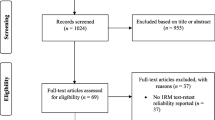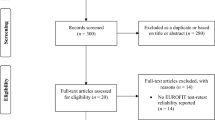Abstract
Background
The Yo-Yo test is widely used both in the practical and research contexts; however, its true test–retest reliability remains unclear.
Objective
The present systematic review aims to identify studies that have examined the test–retest reliability of the Yo-Yo test and summarize their results.
Methods
A search of ten databases was performed to find studies that have investigated test–retest reliability of any variant of the Yo-Yo test. The COSMIN checklist was employed to assess the methodological quality of the included studies.
Results
Nineteen studies of excellent or moderate methodological quality were included. When considering all variants of the Yo-Yo test, the included studies reported intra-class correlation coefficients for test–retest reliability ranging from 0.78 to 0.98 where 62% of all intra-class correlation coefficients were higher than 0.90, while 97% of intra-class correlation coefficients were higher than 0.80. The coefficients of variation ranged from 3.7 to 19.0%. Regardless of the variant of the test, the participants’ familiarization with the test, and previous sport experience, the intra-class correlation coefficients generally seem high (≥ 0.90) and coefficients of variation low (< 10%).
Conclusions
The results of this review indicate that the Yo-Yo test (in all its variants) generally has good-to-excellent test–retest reliability. The evidence concerning reliability arises from 19 included studies that were of moderate or high methodological quality. Considering that most of the included studies examined the Yo-Yo intermittent recovery level 1 test while including Association Football players, more reliability studies examining Yo-Yo intermittent recovery level 2 test and Yo-Yo intermittent endurance level 1 and level 2 tests, and in the context of sports other than Association Football as well as in non-athletic populations, are required. Finally, future studies should explicitly state the type of intra-class correlation coefficient used for the reliability data analysis to allow for better between-study comparisons.

Similar content being viewed by others

References
Bangsbo J, Iaia FM, Krustrup P. The Yo-Yo intermittent recovery test: a useful tool for evaluation of physical performance in intermittent sports. Sports Med. 2008;38(1):37–51.
Bradley PS, Mohr M, Bendiksen M, et al. Sub-maximal and maximal Yo-Yo intermittent endurance test level 2: heart rate response, reproducibility and application to elite soccer. Eur J Appl Physiol. 2011;111(6):969–78.
Krustrup P, Mohr M, Amstrup T, et al. The Yo-Yo intermittent recovery test: physiological response, reliability, and validity. Med Sci Sports Exerc. 2003;35(4):697–705.
Krustrup P, Mohr M, Nybo L, et al. The Yo-Yo IR2 test: physiological response, reliability, and application to elite soccer. Med Sci Sports Exerc. 2006;38(9):1666–73.
Thomas A, Dawson B, Goodman C. The yo-yo test: reliability and association with a 20-m shuttle run and VO(2max). Int J Sports Physiol Perform. 2006;1(2):137–49.
Atkinson G, Nevill AM. Statistical methods for assessing measurement error (reliability) in variables relevant to sports medicine. Sports Med. 1998;26(4):217–38.
Currell K, Jeukendrup AE. Validity, reliability and sensitivity of measures of sporting performance. Sports Med. 2008;38(4):297–316.
Ahler T, Bendiksen M, Krustrup P, et al. Aerobic fitness testing in 6- to 9-year-old children: reliability and validity of a modified Yo-Yo IR1 test and the Andersen test. Eur J Appl Physiol. 2012;112(3):871–6.
Bradley PS, Bendiksen M, Dellal A, et al. The application of the Yo-Yo intermittent endurance level 2 test to elite female soccer populations. Scand J Med Sci Sports. 2014;24(1):43–54.
Castagna C, Bendiksen M, Impellizzeri FM, et al. Reliability, sensitivity and validity of the assistant referee intermittent endurance test (ARIET): a modified Yo-Yo IE2 test for elite soccer assistant referees. J Sports Sci. 2012;30(8):767–75.
Castagna C, Krustrup P, D’Ottavio S, et al. Ecological validity and reliability of an age-adapted endurance field test in young male soccer players. J Strength Cond Res. 2018. https://doi.org/10.1519/jsc.0000000000002255.
Deprez D, Coutts AJ, Lenoir M, et al. Reliability and validity of the Yo-Yo intermittent recovery test level 1 in young soccer players. J Sports Sci. 2014;32(10):903–10.
Deprez D, Fransen J, Lenoir M, et al. The Yo-Yo intermittent recovery test level 1 is reliable in young high-level soccer players. Biol Sport. 2015;32(1):65–70.
Dobbin N, Hunwicks R, Highton J, et al. Reliable testing battery for assessing physical qualities of elite academy rugby league players. J Strength Cond Res. 2018;32(11):3232–8.
Ehlert AM, Cone JR, Wideman L, et al. Evaluation of a goalkeeper-specific adaptation to the Yo-Yo intermittent recovery test level 1: reliability and variability. J Strength Cond Res. 2019;33(3):819–24.
Enright K, Morton J, Iga J, et al. Reliability of “in-season” fitness assessments in youth elite soccer players: a working model for practitioners and coaches. Sci Med Footb. 2018;2(3):177–83.
Fanchini M, Castagna C, Coutts AJ, et al. Are the Yo-Yo intermittent recovery test levels 1 and 2 both useful? Reliability, responsiveness and interchangeability in young soccer players. J Sports Sci. 2014;32(20):1950–7.
Kong Z, Qi F, Shi Q. The influence of basketball dribbling on repeated high-intensity intermittent runs. J Exerc Sci Fit. 2015;13(2):117–22.
Póvoas SC, Castagna C, da Costa Soares JM, et al. Reliability and construct validity of Yo-Yo tests in untrained and soccer-trained schoolgirls aged 9-16. Pediatr Exerc Sci. 2016;28(2):321–30.
Póvoas SC, Castagna C, Soares JM, et al. Reliability and validity of Yo-Yo tests in 9- to 16-year-old football players and matched non-sports active schoolboys. Eur J Sport Sci. 2016;16(7):755–63.
Silva CD, Natali AJ, Lima JRP, et al. Yo-Yo IR2 test and margaria test: validity, reliability and maximum heart rate in young soccer players. Rev Bras Med Esporte. 2011;17(5):344–9.
Yanci J, Granados C, Otero M, et al. Sprint, agility, strength and endurance capacity in wheelchair basketball players. Biol Sport. 2015;32(1):71–8.
Moher D, Liberati A, Tetzlaff J, et al. Preferred reporting items for systematic reviews and meta-analyses: the PRISMA statement. Ann Intern Med. 2009;151(4):264–9.
Koo TK, Li MY. A guideline of selecting and reporting intraclass correlation coefficients for reliability research. J Chiropr Med. 2016;15(2):155–63.
Mokkink LB, Terwee CB, Patrick DL, et al. The COSMIN checklist for assessing the methodological quality of studies on measurement properties of health status measurement instruments: an international Delphi study. Qual Life Res. 2010;19(4):539–49.
Hopkins WG. Measures of reliability in sports medicine and science. Sports Med. 2000;30(1):1–15.
McGraw KO, Wong SP. Forming inferences about some intraclass correlation coefficients. Psychol Methods. 1996;1(1):30–46.
Trevethan R. Intraclass correlation coefficients: clearing the air, extending some cautions, and making some requests. Health Serv Outcomes Res Methodol. 2017;17(2):127–43.
Grgic J, Grgic I, Pickering C, et al. Wake up and smell the coffee: caffeine supplementation and exercise performance. An umbrella review of 21 published meta-analyses. Br J Sports Med. 2019. https://doi.org/10.1136/bjsports-2018-100278.
Mohr M, Nielsen JJ, Bangsbo J. Caffeine intake improves intense intermittent exercise performance and reduces muscle interstitial potassium accumulation. J Appl Physiol. 2011;111(5):1372–9.
Chtourou H, Hammouda O, Souissi H, et al. The effect of ramadan fasting on physical performances, mood state and perceived exertion in young footballers. Asian J Sports Med. 2011;2(3):177–85.
Grgic J, Lazinica B, Garofolini A, et al. The effects of time of day-specific resistance training on adaptations in muscular hypertrophy and strength: a systematic review and meta-analysis. Chronobiol Int. 2019;36(4):449–60.
Chtourou H, Hammouda O, Souissi H, et al. Diurnal variations in physical performances related to football in young soccer players. Asian J Sports Med. 2012;3:139–44.
Mejri MA, Yousfi N, Mhenni T, et al. Does one night of partial sleep deprivation affect the evening performance during intermittent exercise in Taekwondo players? J Exerc Rehabil. 2016;12(1):47–53.
Author information
Authors and Affiliations
Corresponding author
Ethics declarations
Funding
No sources of funding were used to assist in the preparation of this article.
Conflict of Interest
Jozo Grgic, Luca Oppici, Pavle Mikulic, Jens Bangsbo, Peter Krustrup, and Zeljko Pedisic have no conflicts of interest that are directly relevant to the content of this article.
Author Contributions
JG and ZP conceived the idea for the review. JG and LO conducted the study selection, data extraction, and quality assessment. JG drafted the initial manuscript. LO, PM, JB, PK, and ZP contributed to writing the manuscript. All authors approved the final version of the manuscript.
Rights and permissions
About this article
Cite this article
Grgic, J., Oppici, L., Mikulic, P. et al. Test–Retest Reliability of the Yo-Yo Test: A Systematic Review. Sports Med 49, 1547–1557 (2019). https://doi.org/10.1007/s40279-019-01143-4
Published:
Issue Date:
DOI: https://doi.org/10.1007/s40279-019-01143-4



